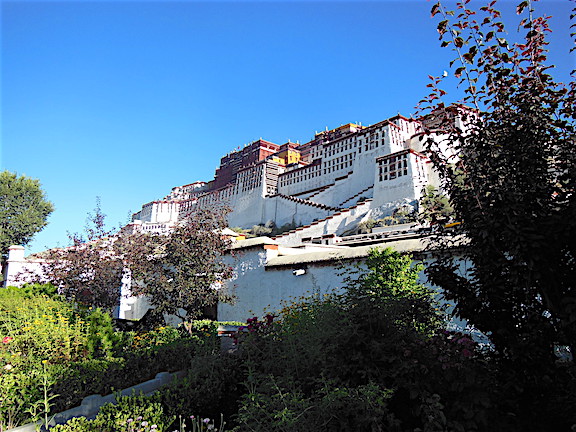
Potala Palace
Table of contents: ()
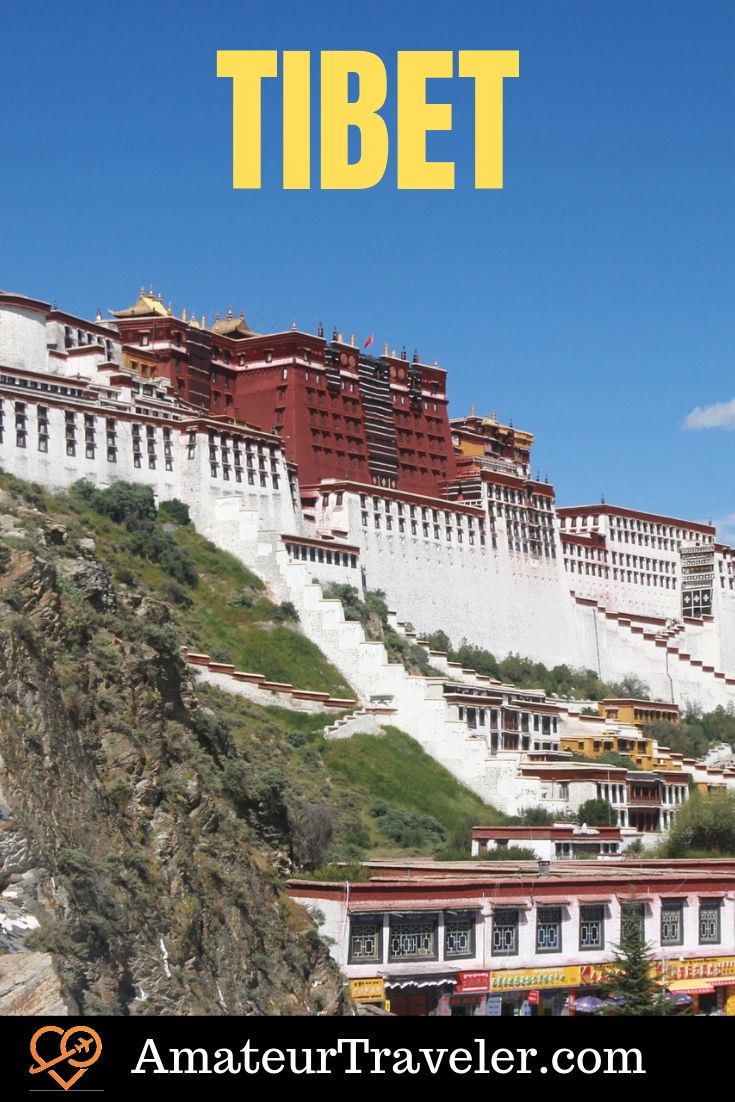
Tibet Itineraries
Many people dream about traveling to Tibet but are often surprised about the limited number of sites and experiences that are available there. Many itineraries to Tibet are around 4 to 5 days and usually begin with a flight into Lhasa followed by a day of rest.
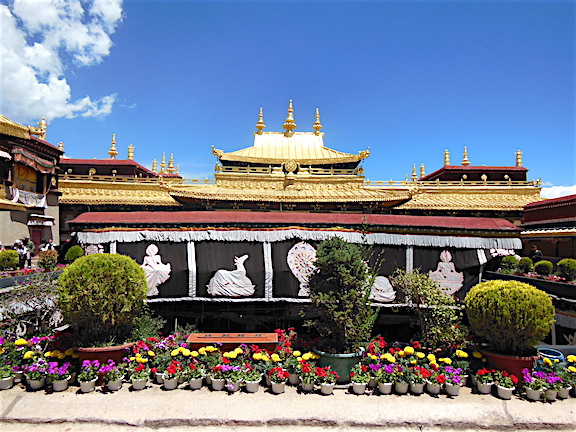
Jokhang Temple
After that, they almost always include a visit to the Potala Palace, the Jokhang Monastery, Barkhor Street, the Drepung Monastery to see the Monk’s debate, the Dalai Lama’s Summer Palace, and possibly a visit to the nearby holy lake. Longer visits may include a journey to the Everest Base Camp.
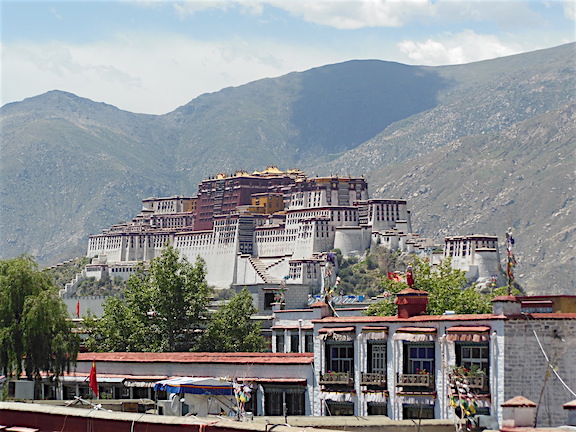
Jokhang Temple Roof
Top Things to Do in Tibet
When my wife and I began planning our trip to Tibet, we decided that we wanted to see all the traditional tourist destinations such as the Potala Palace, but we also wanted to add a day or two to explore some of the scenic beauty of the region.
When we consulted Trip Advisor, we found that a significant number of the “Top Things to Do” were visiting monasteries and temples. Monasteries in China are very interesting to visit, and we have been to many in other areas of China. Personally, I have found that they are very similar, and also I have discovered that even though they may look ancient, they are not always very old or historic. We knew that two or three monasteries would be enough for us.
We would have loved to journey to Everest Base Camp, but we did not have enough time to visit both Lhasa and Everest Base Camp. Also, we knew that the farther our travel date was from winter and spring, the less likely we would be able to see a clear view of Everest.
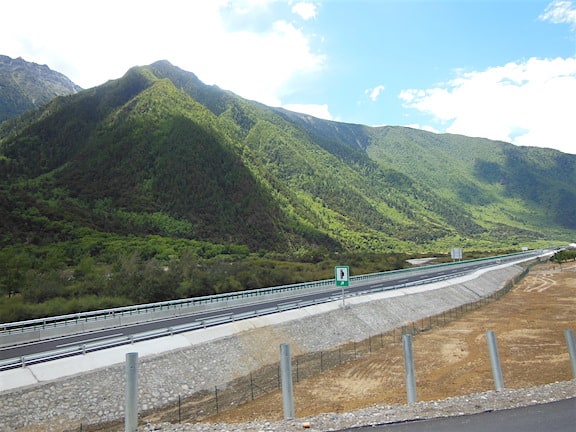
A Drive Through the Lhasa River Valley
When we decided to make this journey, we initially planned to go there by the traditional method of flying directly to Lhasa. After some research and consultation with a Chinese tourist guide, we ended up putting together an itinerary that began by spending two days in lower Tibet, followed by a drive through the Lhasa River Valley, and finishing with four sightseeing days in and around Lhasa.
Our rationale was that we would take a few days to acclimate while also seeing as much of the scenic beauty of Tibet as possible. In lower Tibet, we visited the Luling Primitive Forest and Basum Tso Lake. Both were authentically beautiful. Unfortunately, the drive to Lhasa was exhausting due to the overcrowded roads and the travel restrictions of the Chinese government. These caused very slow travel and excruciating bottlenecks at checkpoints. Much to our dismay, we were physically and mentally exhausted by the time we arrived at Lhasa.
Lhasa
It is worth noting some misconceptions about Lhasa. The city is in the Himalayas, but it is surrounded by mostly low mountains and valleys. Lhasa itself sits on a high elevation plateau, so the landscape does not provide many high mountain vistas. In fact, during the summer, it is unlikely that you will see snow-covered peaks near Lhasa.
The area is classified as semi-arid, and it is not unusual to see large sand dunes as you approach the city. Much of the challenge in visiting Lhasa is dealing with the altitude. The altitude affects everyone in some way. You may not get physically sick, but it will affect your ability to do things. Most people take a full day to relax when they arrive in Lhasa to adjust to the altitude.
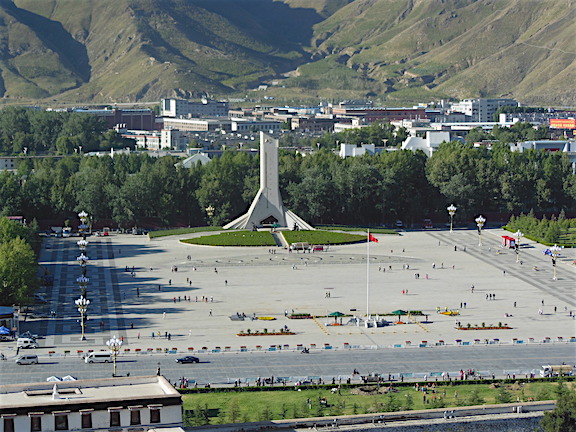
Peace Park
In Lhasa, we lodged at the Shangri-La hotel, refreshed ourselves, and planned to see the traditional sites. These were well worth seeing.
Potala Palace
Any visit to Lhasa must include a visit to the Potala Palace. You will need tickets during the summer tourist season. Take note that the tickets are expensive and are for a timed entry. Prime viewing times in the morning, must be booked well in advance. Lines to get in are long and there are 380 steps to walk up to reach the historic rooms at the top. This was not an easy task in the oxygen-thin air of the Himalayas.
Our guide was great in explaining to us every historic aspect of the building and the monasteries at the top. We spent a full morning investigating every room open to the public. Even more impressive were the outdoor vistas from the upper floors of the palace. We could see the nearby Peace Park, all of Lhasa, and many neighboring mountains.
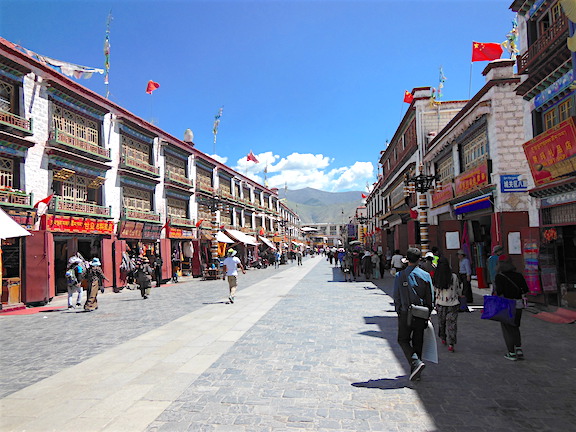
Barkhor Street
Jokhang Monastery
Our afternoon visit was to the Jokhang Monastery. The real value of visiting this site is going to the roof to see the exceptional views of downtown Lhasa and the Potala Palace. Outside the Jokhang Monastery, we visited Barkhor Street, a traditional touristy shopping street. There were many stores here, but most of them sold similar types of merchandise. It was a fun way to spend an hour, but in general, it was difficult to bargain and was very touristy.
Ballad of Princess Wencheng
We were back at our hotel by early afternoon and decided to see a live, outdoor show called the Ballad of Princess Wencheng in the evening. The show was a spectacle that contained a cast of 600 actors, 30 sheep, and 80 yaks. This is the kind of thing you can only see in China. Even though the show was overpriced, we enjoyed it.
Unfortunately, to get there we had to climb up over 300 steps to enter the theater. Later that evening, back at the hotel, the physical exertion of this experience triggered severe symptoms of altitude sickness with my wife. She ended up having to rest in bed for the remainder of our days in Tibet and even had to make a trip to the hospital for an oxygen treatment. I was fine, and once my wife was resting peacefully, I decided to push on with a few of the remaining items we had booked for our trip.
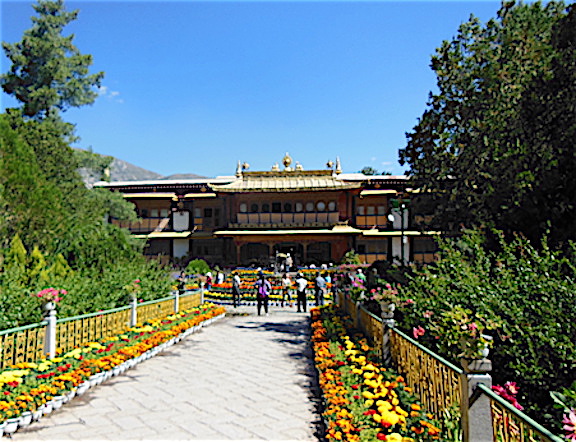
Norbulingka Park
Norbulingka Park
One experience I enjoyed was a trip to Norbulingka Park to see the traditional summer residences of the Dalai Llamas since 1780. Of course, the current Dalai Lama fled Tibet in 1959, so these residences are historical buildings.
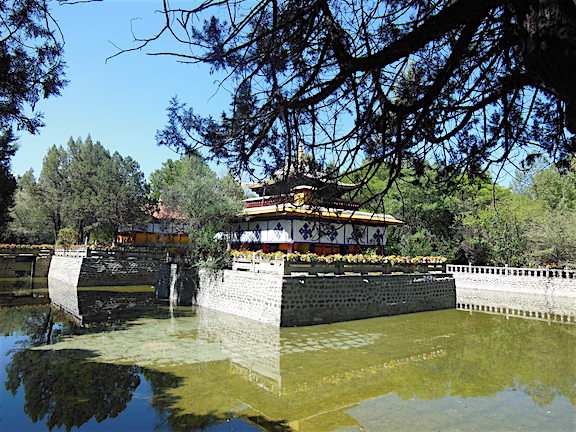
Norbulingka Park
It was fascinating to see the progression of separate homes where past Dalai Llamas worked away from the Potala Palace. I actually enjoyed this experience as much as any site we saw in Lhasa due mostly to the peacefulness and beauty of the park. It was also fascinating to see the human side of the Dalai Lama’s life.
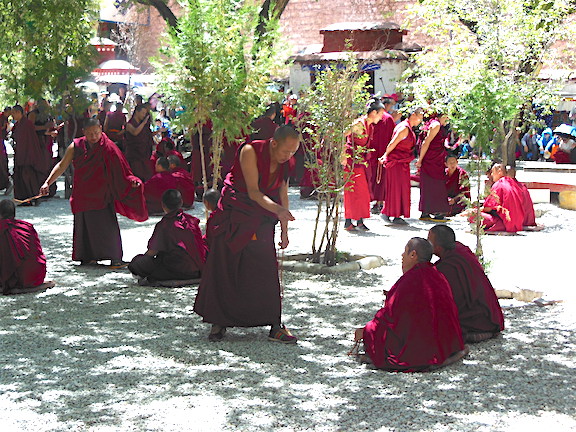
Monk’s Debate
Drepung Monastery
After returning to our hotel (which was only two blocks from Norbulingka Park) to check on my wife, I then took an afternoon excursion to the Drepung Monastery to visit the Assembly Hall and experience the monk’s debating in a courtyard. The debate seemed more of a staged tourist event than anything else, but it was interesting and enhanced my experience of visiting the monastery.
Upon my return, I found that my wife was getting better, but she was not ready to venture from the hotel. Due to her need to recuperate, we did not get to spend time exploring the city of Lhasa at night. Lhasa does have a vibrant downtown that includes many restaurants and places to shop.
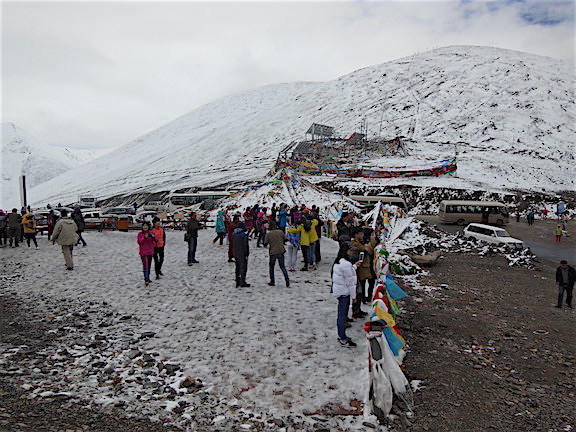
Lake Namtso
Lake Namtso
On my last full day in Lhasa, I traveled with my guide to the holy lake of Namtso. I chose this lake because it was farther from Lhasa than other holy lakes and was at a much higher elevation (15,479 ft / 4,718 m).
The day began with a rainy mist in the Lhasa Valley, and of course, the main travel road had multiple checkpoints. The drive was slow, but it was incredibly scenic. Here I saw winding river valleys, inspiring mountain vistas, along with the intrusion of new high-speed train lines.
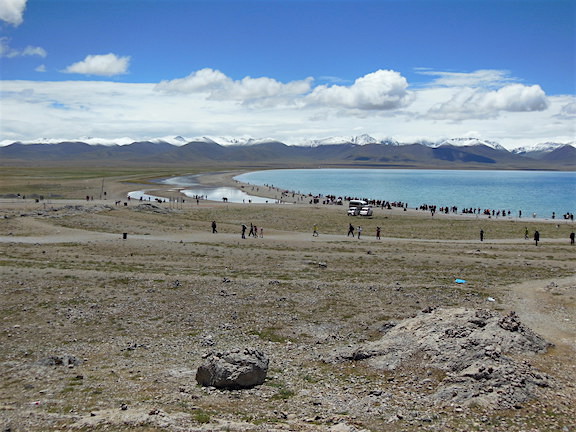
Lake Namtso
As we rose in elevation, I began to see snow-covered peaks with small glaciers filling the areas in-between. The scenery was breath-taking. To get to the lake, we had to traverse one of the snow-covered passes (at an elevation of 16,761 ft) and drive down the other side to the lake. This was truly the Tibet of my imagination, and I look back at this being my finest memory of Tibet. I was the only Westerner I saw on this day.
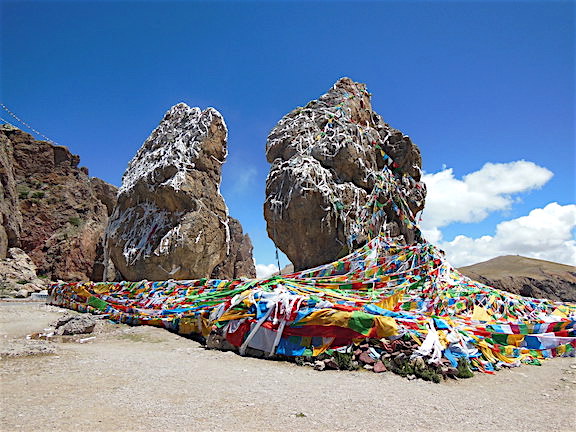
Lake Namtso
Lake Namtso is a pilgrimage site and there were many people visiting on this sunny, but cold summer day. The salt-water lake was ringed by high mountains, but there was a large flat area in-between the mountains and the lake. The terrain was tundra-like and there were no trees.
Security was very tight here. To enter the lake area, we again had to pass multiple checkpoints. At the last one, I actually had to get out, show my passport, and be inspected.
Inside the lake complex there was an area that contained campsites for visitors and tents for groups to eat. There were also touristy markets and food vendors. The lake is the focal point of this region, and everyone headed there first.
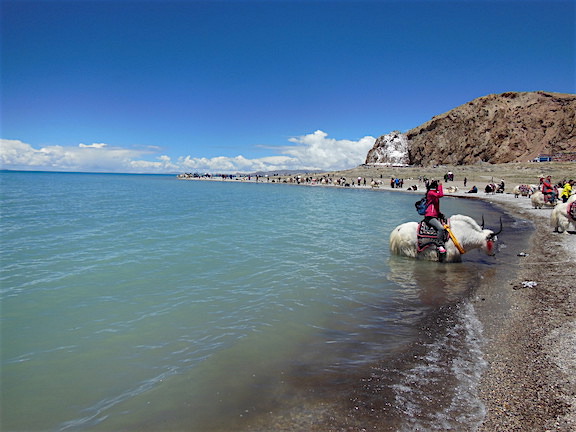
Lake Namtso
A popular attraction for many people was to have their photograph taken on a yak that was standing in the water. In addition, there were some rock outcroppings that had been turned into shrines along with some Buddhist temples. We spent about an hour and a half at the lake before heading back. It was a remarkably enjoyable and scenic excursion.
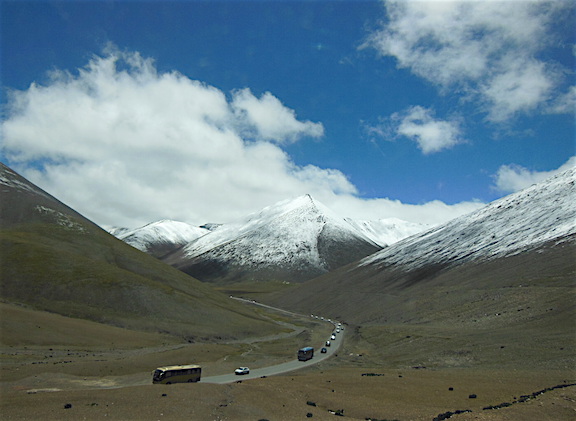
Lake Namtso
On the way back, we stopped at the Yangpachen thermal hot springs resort, but I elected not to swim. Even though the water was extremely warm, the air was very cold. Nonetheless, it was very exhilarating standing next to the warm hot springs and looking up at the mountains covered with glaciers.
My guide and driver had planned to stop for lunch at a Tibetan restaurant on the way back, but it took a long time for them to find a suitable place. Eventually, they complained that even though there were many restaurants along the road, they all served Chinese food, not Tibetan. Even here, in far Tibet, I could easily sense the frustration of the Tibetans as they experienced the takeover of the Han Chinese.
By this point, my wife had almost recovered, but we had to leave for our flight back to Shanghai. The drive from Lhasa to the airport was almost an hour on a fairly modern highway. There were more security checkpoints on the way, as well as at the airport entrance. Eventually, we made it to our gate only to find that our flight was delayed for almost three hours. Even worse, our luggage never accompanied us to Shanghai, and we did not see it until two days later.
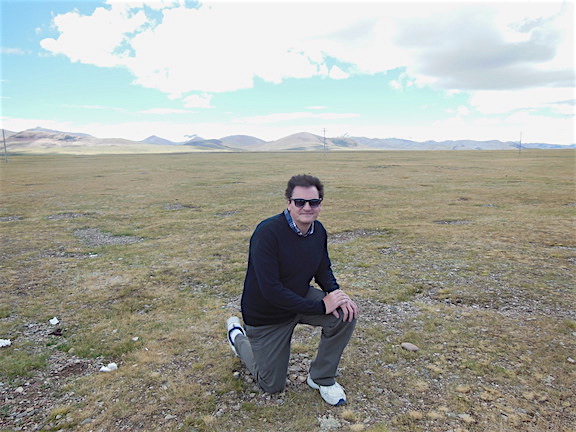
Lake Namtso
Conclusion
Tibet was different and tougher than I expected. The stark Himalayan landscape and dry climate were unlike any mountains I had experienced before. The beauty of the region is its ruggedness, but every day the landscape is being tamed by the Chinese government through mass building programs, high rise apartments, energy projects, modern trains, and multi-lane highways. The movement of tourists is very restricted, and military personnel are visible everywhere. The control of the Chinese government was more evident here than anywhere else I have been in China.
Do not expect to experience Shangri-La in Lhasa. In fact, I found it difficult to find any spiritualness among the intensity of the tourism that has flooded the region. At the same time, there were glimpses of the exoticness and remoteness of the past. The majesty of the Potala Palace and the pristine peacefulness of Lake Namtso have become two of my greatest travel memories. I believe it is still worth the effort to experience Tibet, but realize that it has already moved far from its isolated past and is well into the modern world.


 Tibet Holiday – A Different Road to Lhasa
Tibet Holiday – A Different Road to Lhasa Travel to Tibet – Episode 528
Travel to Tibet – Episode 528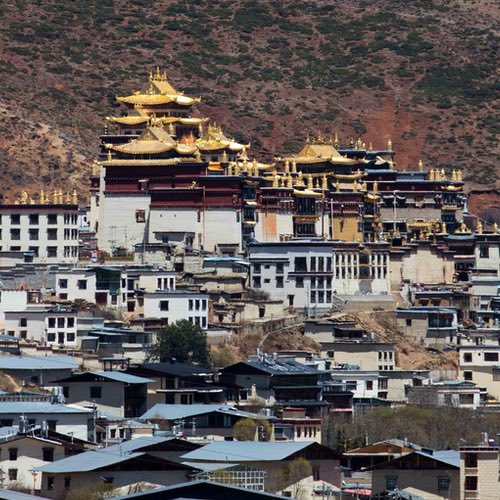 Tibetan Culture in Sichuan, Yunnan, and Qinghai: Tibet Without the Hassle
Tibetan Culture in Sichuan, Yunnan, and Qinghai: Tibet Without the Hassle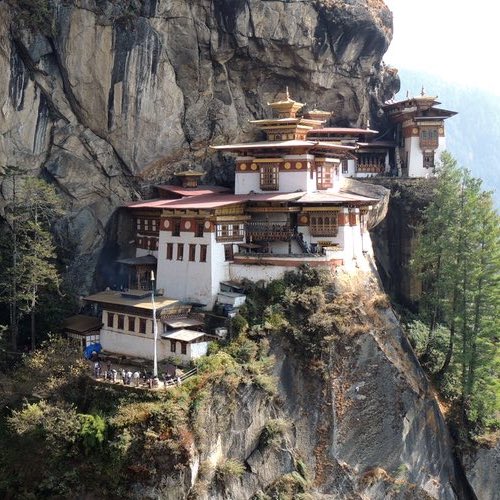 Places to Visit in Nepal and Bhutan, the Roof of the World
Places to Visit in Nepal and Bhutan, the Roof of the World

